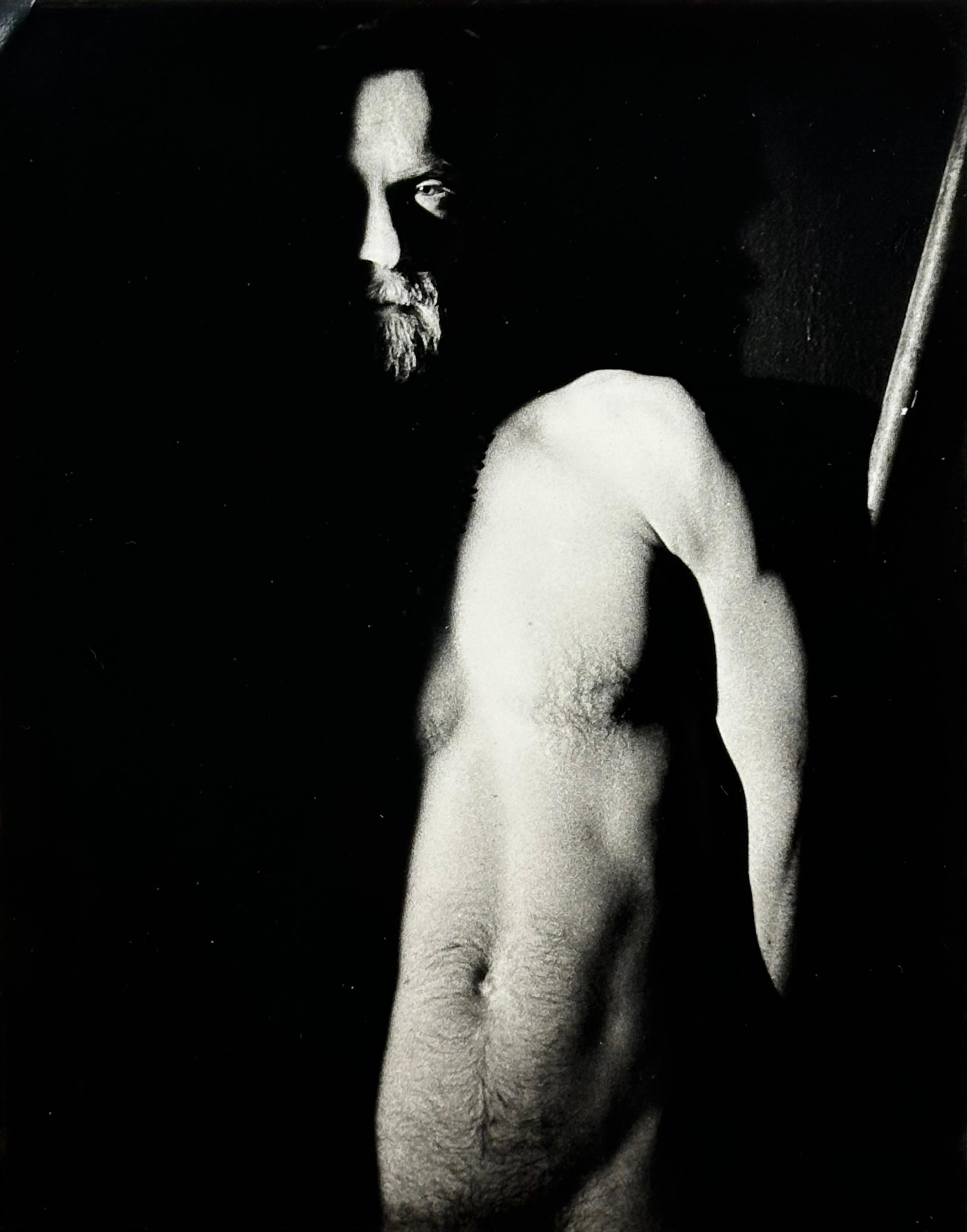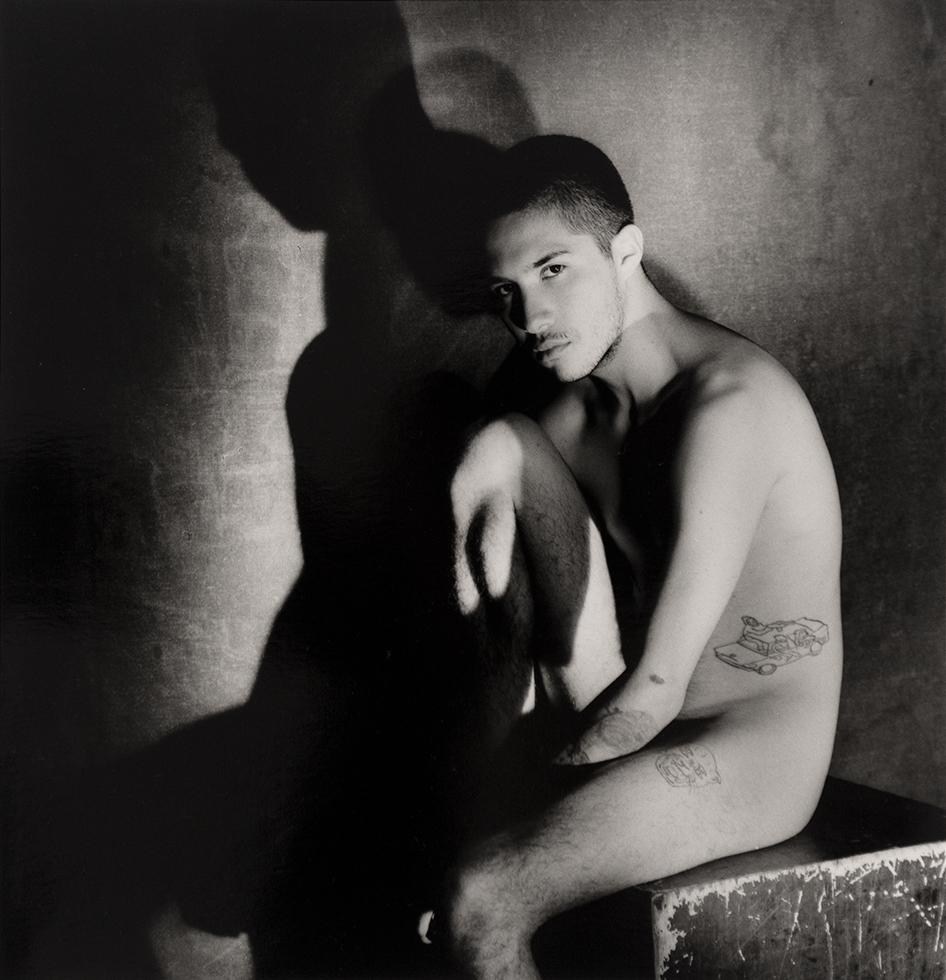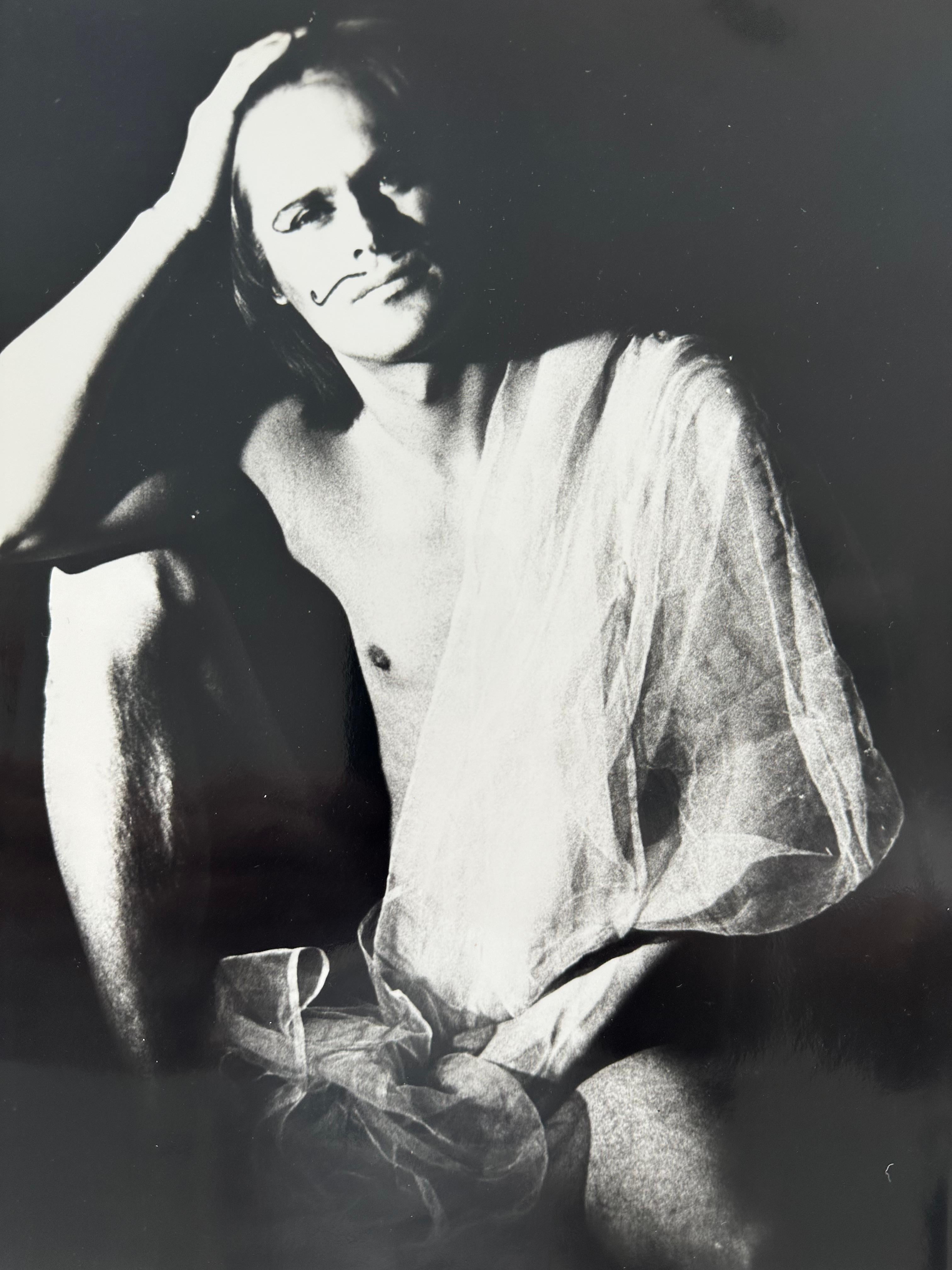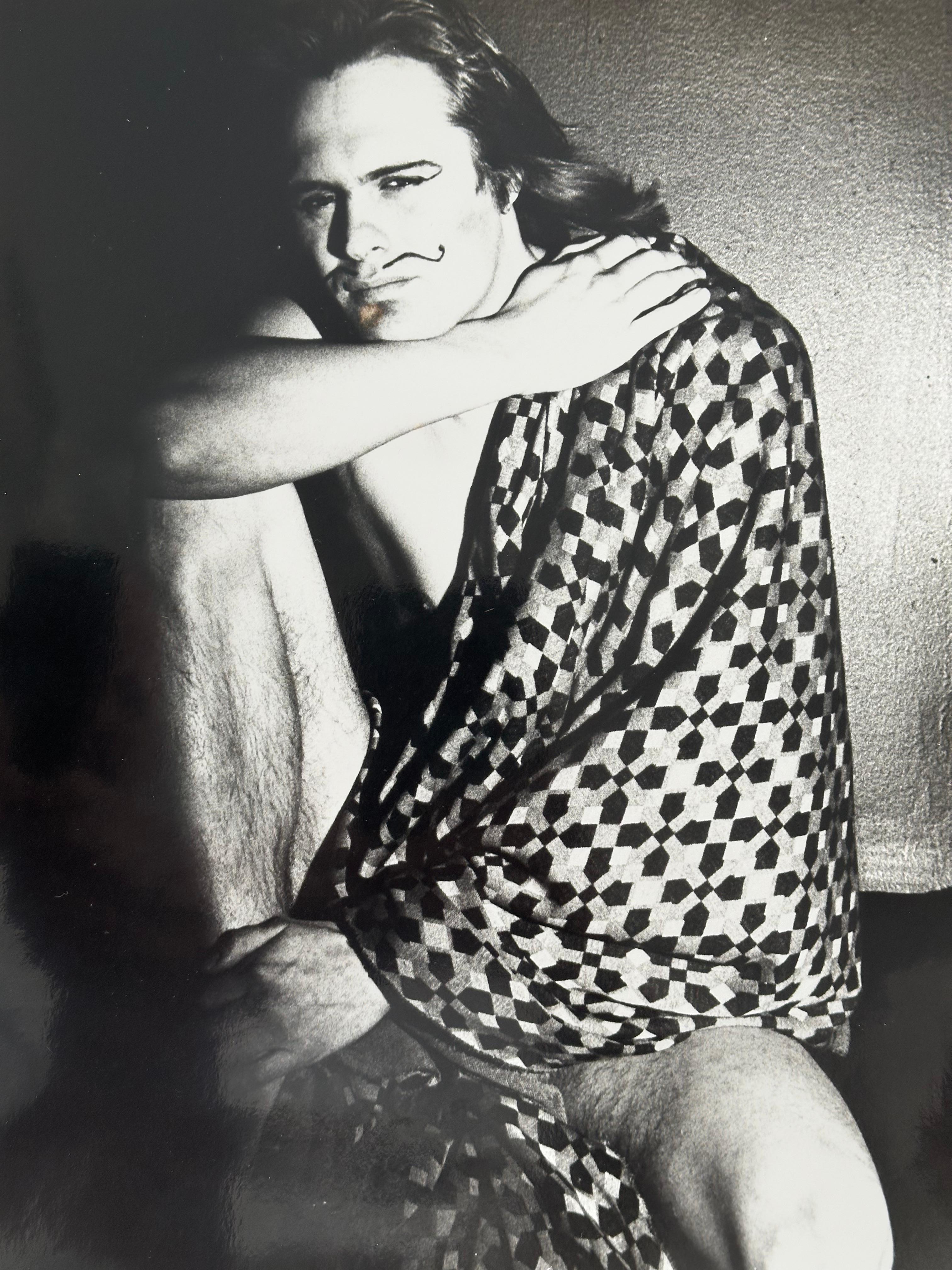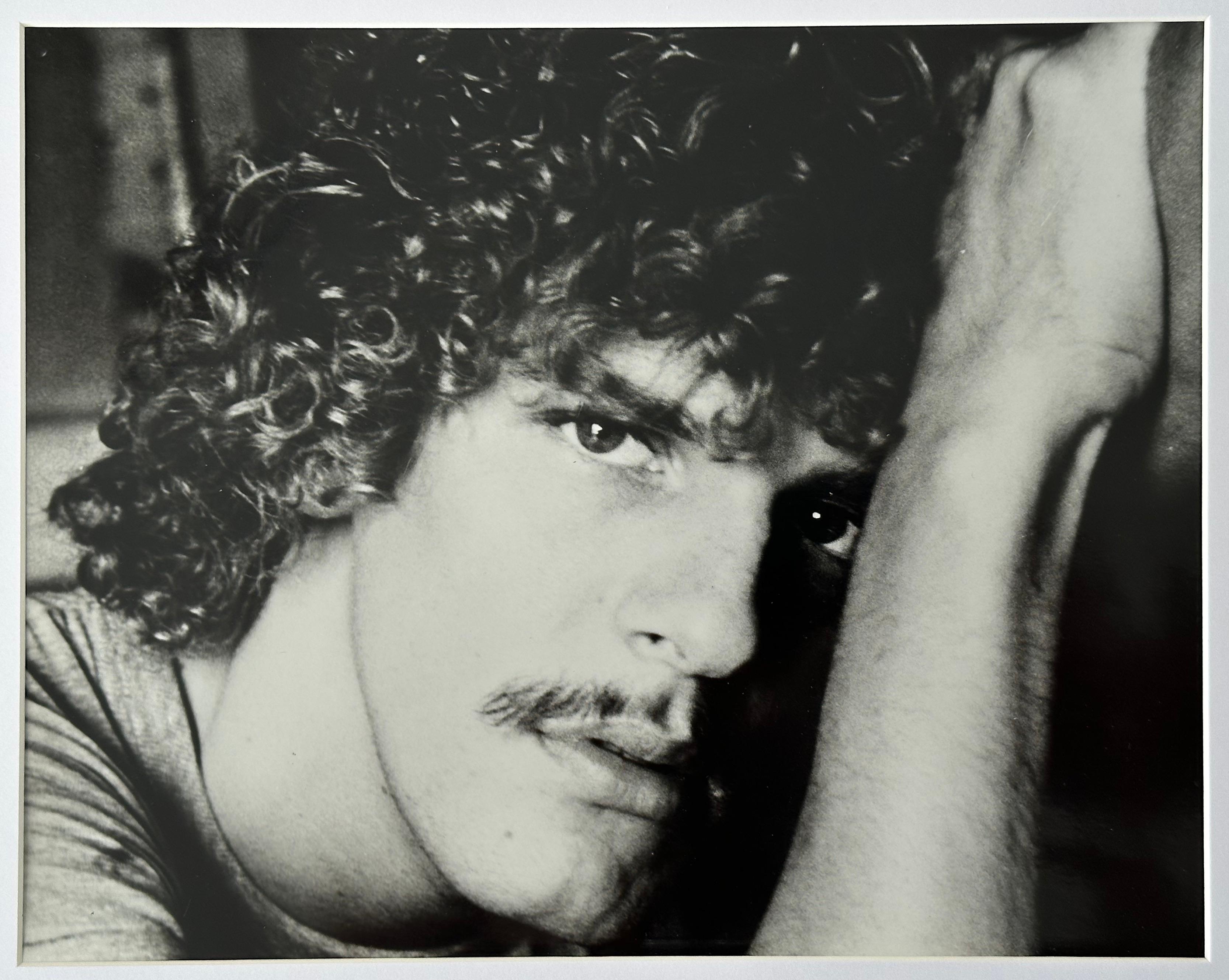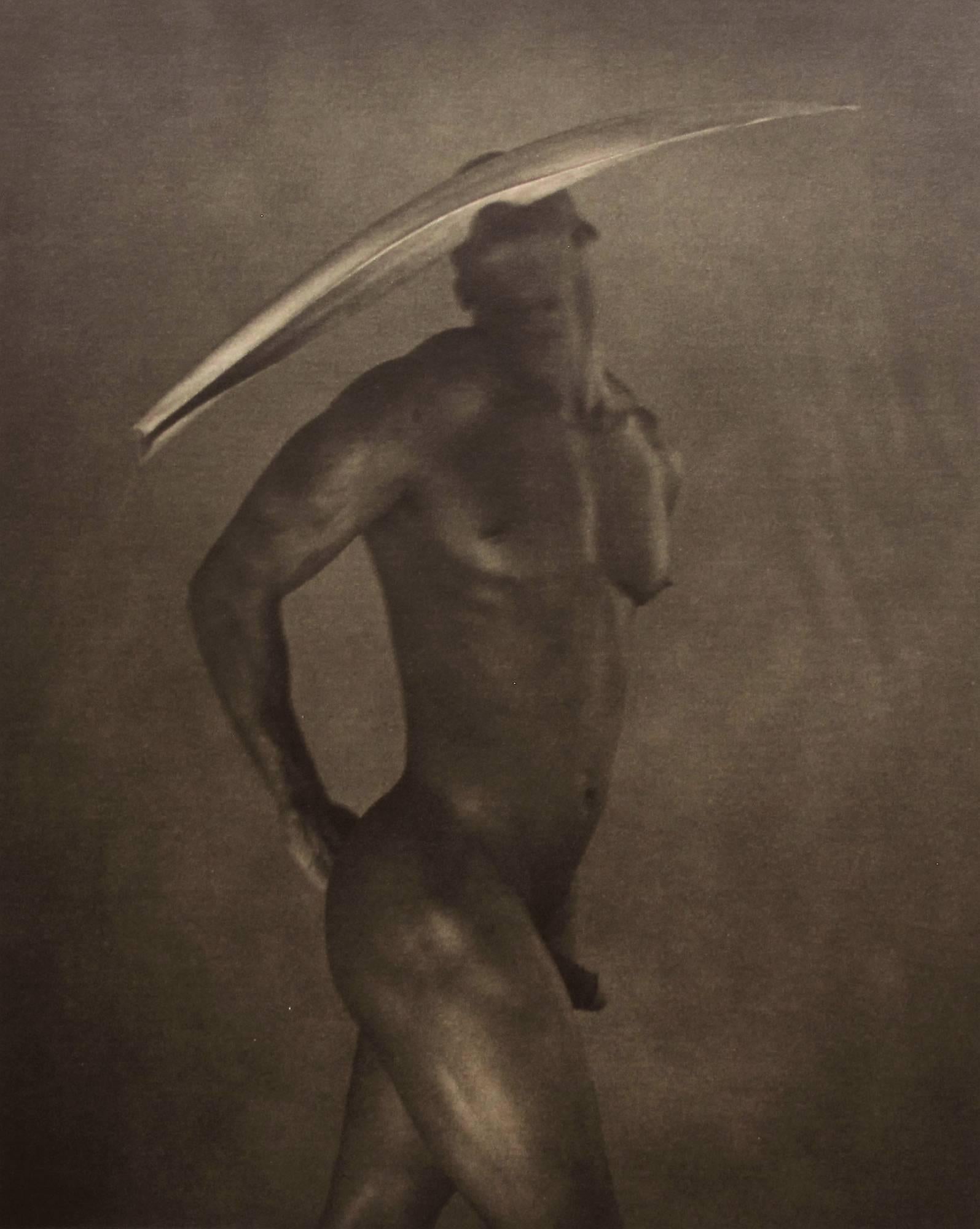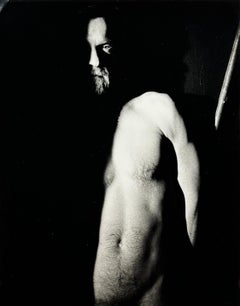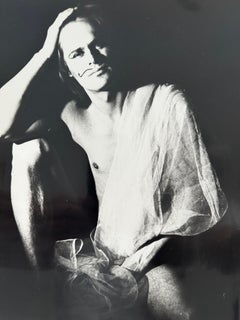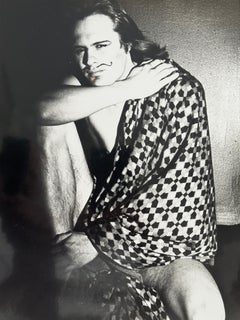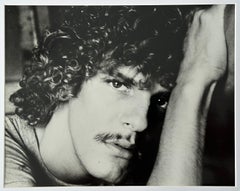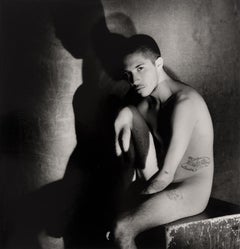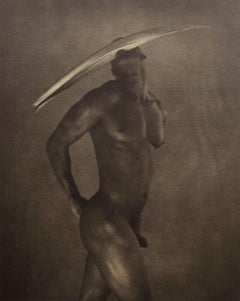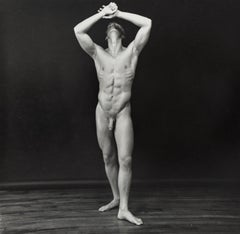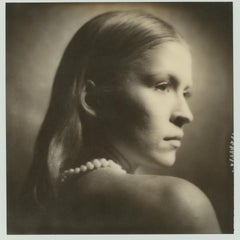Want more images or videos?
Request additional images or videos from the seller
1 of 5
Victor ArimondiPortraitca. 1975
ca. 1975
$800
£604.24
€698.33
CA$1,122.12
A$1,248.09
CHF 653.22
MX$15,222.56
NOK 8,207.98
SEK 7,720.67
DKK 5,212.36
About the Item
Victor Arimondi (1942-2001). Portrait, ca. 1975. Period print measures 11 x 14 inches. Artist studio stamp on verso.
Victor Arimondi (November 8, 1942 – July 24, 2001) was an Italian American photographer and model who lived and worked in Europe before moving to the United States in the late 1970s. His early fashion photography, his portraits of Grace Jones and other artists, and his male nudes photographed in New York and San Francisco captured the pre-AIDS culture of the 1970s and early 1980s.
Arimondi's nudes were collected in several books, including David Leddick's award-winning[1] The Male Nude, (New York: Taschen 1998, 2005 and 2015). The photographer's later work documented homeless individuals in San Francisco's Tenderloin neighborhood and the toll of the AIDS epidemic on the city. His photographs, featured in several posthumous exhibitions, also are in the collections of Sweden's museum of modern art, Moderna Museet, and San Francisco's GLBT Historical Society.
Biography
Arimondi was born Vittorio Maria Tevitti to his unwed mother, Alessandra Calligaris, in Bologna, Italy on November 8, 1942. His mother struggled financially, which left an impression on her only child. In 1948, she temporarily left him at a children's boarding school and orphanage in Italy to move to Sweden for a job. There she met and married Bruno Arimondi, who adopted her son. The family returned to Naples, Italy in 1952 where Victor graduated from high school.[1]
In 1960, Arimondi returned to Sweden to study at the University College of Arts, Crafts and Design in Stockholm, although he did not graduate. Meanwhile, he worked at several blue collar jobs, including as a mailman, before he gave up on traditional full-time work to pursue what he considered more essential— a life of creative expression. He created costume-like clothing for himself and friends and at age 19 became a fashion model.
Even as a teenager, the Italian born photographer who spent his 20s and 30s primarily based in Sweden, noted that he preferred fantasy to the trials of real life.[1] That conflict, and his passion for beauty as well as his sexual energy, were major factors in his life and his work.[2]
From 1965 through 1972 Arimondi worked as model in London, Milan, Germany, New York and Stockholm, appearing in catalogs and fashion magazines including Vogue , Harper's Bazaar and Esquire and on the runway in several Valentino fashion shows.
In 1972 he decided to try working on the other side of the lens as a photographer to better express his creativity.[2]
Arimondi moved to New York in 1979 and continued to build his photography portfolio.
Portrait of Bearded Man, New York City, 1979
Two years later, in 1981, he moved to San Francisco where he lived and worked for twenty years until his death of AIDS at age 58 on July 24, 2001.
The year he moved to San Francisco, Arimondi opened a photo gallery in the Haight-Ashbury neighborhood for a short time. When he struggled financially, he gave up on trying to earn a living through commercial fashion photography and closed the gallery.[3]
Arimondi returned to modeling for the financial benefits, though he did so on less of an international scale than in his early years.
He continued to create photographic portraits of the denizens of the San Francisco gay and arts cultures, to shoot male nudes and publish his work in magazines, and he began to compose and photograph evocative still lifes using his own photographic images. Many of them touched on the death of dozens of his former photography models from AIDS.
Arimondi was in the midst of a new photography project that brought together his background as a fashion photographer and his more recent social documentary work when he died several months after he learned he was HIV-positive.[4] The project featured his former colleague, haute couture cover model Ivy Nicholson,[5] who he found living homeless in San Francisco. Several of the haunting portraits he took of her were later included in a noted group exhibit at SF Camerawork.
Art
Arimondi's early photography in the 1970s in Stockholm included portraits of the stars of Sweden's fashion, theater and dance worlds. His first two photography exhibits were in Stockholm and met with mixed reviews. But as he matured as a photographer and tapped into his fashion world contacts, Arimondi landed a number of commercial fashion jobs, including shooting for the Italian designer Salvatore Ferragamo S.p.A.'s I.Magnin department store ad that ran in Vogue.
Marlboro Man Nude, New York City,1980.
He also shot other artists and models for his own portfolio, including Grace Jones, the Norwegian actress, Liv Ullmann, and the American writer, Norman Mailer.
Arimondi's aesthetic vision was focused on fantasy and drama, and he prided himself on pushing limits.[6]
Although less well-known than his San Francisco contemporary, photographer Robert Mapplethorpe, whose work was shown alongside Arimondi's in photography exhibits and books, Arimondi, too, was noted for his male nudes.[7] Arimondi's compositions, though, often combined a dream-like affect with the sensual. His distinctive use of light and shadow also distinguished his work from that of other photographers of the time.[8]
Although his male nudes were published in a number of books and magazines around the world, and his photos were shown in galleries from New York to Tokyo, the exposure did not always translate into sustainable profits. Arimondi's work as a fashion model helped pay his bills.
Fashion Photography, San Francisco, 1981.
In his last years Arimondi's photography began to take a turn to social documentary with individual portraits of homeless men and women and images of construction workers on the streets of San Francisco.[8]
Arimondi's circa 1990 photography exhibit in San Francisco, "55 x 1", featured images of evocative still lifes he composed using his early portraits of 55 models who had subsequently died from HIV/AIDS.
In 1992, he donated 30 of his photography works to Sweden's museum of modern art, Moderna Museet, in Stockholm.
His work, often poignant, typically focused on the humanity behind an image, no matter how striking, and was valued for its historic and documentary value, as well as its artistic merit.[9]
From the heady days of his international fashion career and the New York disco scene of the 1970s to the liberated gay culture of San Francisco during that decade to the growing toll of AIDS and homelessness as the 1980s began, Arimondi captured his times with photography others considered ahead of his time.[10]
Selected works
Arimondi, Victor. The Look of Men. London: Colour Library International Ltd., 1980. ISBN 0906558425
Arimondi, Victor. Boyfriends. New York: Arlington House, 1st English edition, 1984. ISBN 9780517554821
Leddick, David. The Male Nude. New York: Taschen, 1st edition, 1998. ISBN 978-3-8228-7966-5; Taschen Bibliotheca Universalis edition, 2015. ISBN 978-3-8365-5801-3
Gale, Patrick. Armistead Maupin. (Cover photo by Arimondi) England, Bath: Absolute Press, Revised Edition, 2000. ISBN 978-1899791378
Selected Exhibits
1999: "From Vogue to Homeless: 20 Years of Photography in the U.S.,” Muddy Waters Cafe gallery, San Francisco[8]
2002: “Arimondi: A Retrospective,” Atelier Studio Gallery, San Francisco.[4]
2004: “Victor Arimondi,” Geras Tousignant Gallery, San Francisco [7]
2009: “A Compassionate Eye: The Work of Victor Arimondi,” James C. Hormel Gay and Lesbian Center at the Main Library, San Francisco.[4]
2010: “Autobiography of the San Francisco Bay Area, Part 2: The Future Lasts Forever,” Group show, SF Camerawork, San Francisco[7]
- Creator:Victor Arimondi (1942 - 2001, Italian)
- Creation Year:ca. 1975
- Dimensions:Height: 11 in (27.94 cm)Width: 14 in (35.56 cm)
- Medium:
- Movement & Style:
- Period:
- Framing:Framing Options Available
- Condition:
- Gallery Location:Wilton Manors, FL
- Reference Number:1stDibs: LU245214737282
About the Seller
4.9
Platinum Seller
Premium sellers with a 4.7+ rating and 24-hour response times
Established in 2007
1stDibs seller since 2015
417 sales on 1stDibs
Typical response time: 2 hours
- ShippingRetrieving quote...Shipping from: Wilton Manors, FL
- Return Policy
Authenticity Guarantee
In the unlikely event there’s an issue with an item’s authenticity, contact us within 1 year for a full refund. DetailsMoney-Back Guarantee
If your item is not as described, is damaged in transit, or does not arrive, contact us within 7 days for a full refund. Details24-Hour Cancellation
You have a 24-hour grace period in which to reconsider your purchase, with no questions asked.Vetted Professional Sellers
Our world-class sellers must adhere to strict standards for service and quality, maintaining the integrity of our listings.Price-Match Guarantee
If you find that a seller listed the same item for a lower price elsewhere, we’ll match it.Trusted Global Delivery
Our best-in-class carrier network provides specialized shipping options worldwide, including custom delivery.More From This Seller
View AllPortrait
Located in Wilton Manors, FL
Portrait, ca. 1975. Period print measuring 8.75 x 11.25 inches. Unframed.
Studio stamp on verso.
Mounting and framing services available.
Victor Arimondi (November 8, 1942 – July 24, 2001) was an Italian American photographer and model who lived and worked in Europe before moving to the United States in the late 1970s. His early fashion photography, his portraits of Grace Jones and other artists, and his male nudes photographed in New York and San Francisco captured the pre-AIDS culture of the 1970s and early 1980s.
Arimondi's nudes were collected in several books, including David Leddick's award-winning[1] The Male Nude, (New York: Taschen 1998, 2005 and 2015). The photographer's later work documented homeless individuals in San Francisco's Tenderloin neighborhood and the toll of the AIDS epidemic on the city. His photographs, featured in several posthumous exhibitions, also are in the collections of Sweden's museum of modern art, Moderna Museet, and San Francisco's GLBT Historical Society.
Biography
Arimondi was born Vittorio Maria Tevitti to his unwed mother, Alessandra Calligaris, in Bologna, Italy on November 8, 1942. His mother struggled financially, which left an impression on her only child. In 1948, she temporarily left him at a children's boarding school and orphanage in Italy to move to Sweden for a job. There she met and married Bruno Arimondi, who adopted her son. The family returned to Naples, Italy in 1952 where Victor graduated from high school.[1]
In 1960, Arimondi returned to Sweden to study at the University College of Arts, Crafts and Design in Stockholm, although he did not graduate. Meanwhile, he worked at several blue collar jobs, including as a mailman, before he gave up on traditional full-time work to pursue what he considered more essential— a life of creative expression. He created costume-like clothing for himself and friends and at age 19 became a fashion model.
Even as a teenager, the Italian born photographer who spent his 20s and 30s primarily based in Sweden, noted that he preferred fantasy to the trials of real life.[1] That conflict, and his passion for beauty as well as his sexual energy, were major factors in his life and his work.[2]
From 1965 through 1972 Arimondi worked as model in London, Milan, Germany, New York and Stockholm, appearing in catalogs and fashion magazines including Vogue , Harper's Bazaar and Esquire and on the runway in several Valentino fashion shows.
In 1972 he decided to try working on the other side of the lens as a photographer to better express his creativity.[2]
Arimondi moved to New York in 1979 and continued to build his photography portfolio.
Portrait of Bearded Man, New York City, 1979
Two years later, in 1981, he moved to San Francisco where he lived and worked for twenty years until his death of AIDS at age 58 on July 24, 2001.
The year he moved to San Francisco, Arimondi opened a photo gallery in the Haight-Ashbury neighborhood for a short time. When he struggled financially, he gave up on trying to earn a living through commercial fashion photography and closed the gallery.[3]
Arimondi returned to modeling for the financial benefits, though he did so on less of an international scale than in his early years.
He continued to create photographic portraits of the denizens of the San Francisco gay and arts cultures, to shoot male nudes and publish his work in magazines, and he began to compose and photograph evocative still lifes using his own photographic images. Many of them touched on the death of dozens of his former photography models from AIDS.
Arimondi was in the midst of a new photography project that brought together his background as a fashion photographer and his more recent social documentary work when he died several months after he learned he was HIV-positive.[4] The project featured his former colleague, haute couture cover model Ivy Nicholson,[5] who he found living homeless in San Francisco. Several of the haunting portraits he took of her were later included in a noted group exhibit at SF Camerawork.
Art
Arimondi's early photography in the 1970s in Stockholm included portraits of the stars of Sweden's fashion, theater and dance worlds. His first two photography exhibits were in Stockholm and met with mixed reviews. But as he matured as a photographer and tapped into his fashion world contacts, Arimondi landed a number of commercial fashion jobs, including shooting for the Italian designer Salvatore Ferragamo S.p.A.'s I.Magnin department store ad that ran in Vogue.
Marlboro Man Nude, New York City,1980.
He also shot other artists and models for his own portfolio, including Grace Jones, the Norwegian actress, Liv Ullmann, and the American writer, Norman Mailer.
Arimondi's aesthetic vision was focused on fantasy and drama, and he prided himself on pushing limits.[6]
Although less well-known than his San Francisco contemporary...
Category
1970s Realist Black and White Photography
Materials
Photographic Paper
Portrait of Nude Man
Located in Wilton Manors, FL
Victor Arimondi (1942-2001). Portrait, ca. 1975. Period print measures 11 x 14 inches. Artist studio stamp on verso.
Victor Arimondi (November 8, 1942 – July 24, 2001) was an Italian American photographer and model who lived and worked in Europe before moving to the United States in the late 1970s. His early fashion photography, his portraits of Grace Jones and other artists, and his male nudes photographed in New York and San Francisco captured the pre-AIDS culture of the 1970s and early 1980s.
Arimondi's nudes were collected in several books, including David Leddick's award-winning[1] The Male Nude, (New York: Taschen 1998, 2005 and 2015). The photographer's later work documented homeless individuals in San Francisco's Tenderloin neighborhood and the toll of the AIDS epidemic on the city. His photographs, featured in several posthumous exhibitions, also are in the collections of Sweden's museum of modern art, Moderna Museet, and San Francisco's GLBT Historical Society.
Biography
Arimondi was born Vittorio Maria Tevitti to his unwed mother, Alessandra Calligaris, in Bologna, Italy on November 8, 1942. His mother struggled financially, which left an impression on her only child. In 1948, she temporarily left him at a children's boarding school and orphanage in Italy to move to Sweden for a job. There she met and married Bruno Arimondi, who adopted her son. The family returned to Naples, Italy in 1952 where Victor graduated from high school.[1]
In 1960, Arimondi returned to Sweden to study at the University College of Arts, Crafts and Design in Stockholm, although he did not graduate. Meanwhile, he worked at several blue collar jobs, including as a mailman, before he gave up on traditional full-time work to pursue what he considered more essential— a life of creative expression. He created costume-like clothing for himself and friends and at age 19 became a fashion model.
Even as a teenager, the Italian born photographer who spent his 20s and 30s primarily based in Sweden, noted that he preferred fantasy to the trials of real life.[1] That conflict, and his passion for beauty as well as his sexual energy, were major factors in his life and his work.[2]
From 1965 through 1972 Arimondi worked as model in London, Milan, Germany, New York and Stockholm, appearing in catalogs and fashion magazines including Vogue , Harper's Bazaar and Esquire and on the runway in several Valentino fashion shows.
In 1972 he decided to try working on the other side of the lens as a photographer to better express his creativity.[2]
Arimondi moved to New York in 1979 and continued to build his photography portfolio.
Portrait of Bearded Man, New York City, 1979
Two years later, in 1981, he moved to San Francisco where he lived and worked for twenty years until his death of AIDS at age 58 on July 24, 2001.
The year he moved to San Francisco, Arimondi opened a photo gallery in the Haight-Ashbury neighborhood for a short time. When he struggled financially, he gave up on trying to earn a living through commercial fashion photography and closed the gallery.[3]
Arimondi returned to modeling for the financial benefits, though he did so on less of an international scale than in his early years.
He continued to create photographic portraits of the denizens of the San Francisco gay and arts cultures, to shoot male nudes and publish his work in magazines, and he began to compose and photograph evocative still lifes using his own photographic images. Many of them touched on the death of dozens of his former photography models from AIDS.
Arimondi was in the midst of a new photography project that brought together his background as a fashion photographer and his more recent social documentary work when he died several months after he learned he was HIV-positive.[4] The project featured his former colleague, haute couture cover model Ivy Nicholson,[5] who he found living homeless in San Francisco. Several of the haunting portraits he took of her were later included in a noted group exhibit at SF Camerawork.
Art
Arimondi's early photography in the 1970s in Stockholm included portraits of the stars of Sweden's fashion, theater and dance worlds. His first two photography exhibits were in Stockholm and met with mixed reviews. But as he matured as a photographer and tapped into his fashion world contacts, Arimondi landed a number of commercial fashion jobs, including shooting for the Italian designer Salvatore Ferragamo S.p.A.'s I.Magnin department store ad that ran in Vogue.
Marlboro Man Nude, New York City,1980.
He also shot other artists and models for his own portfolio, including Grace Jones, the Norwegian actress, Liv Ullmann, and the American writer, Norman Mailer.
Arimondi's aesthetic vision was focused on fantasy and drama, and he prided himself on pushing limits.[6]
Although less well-known than his San Francisco contemporary...
Category
1970s Realist Black and White Photography
Materials
Photographic Paper
Portrait of Nude Man
Located in Wilton Manors, FL
Victor Arimondi (1942-2001). Portrait, ca. 1975. Period print measures 11 x 14 inches. Artist studio stamp on verso.
Victor Arimondi (November 8, 1942 – July 24, 2001) was an Italian American photographer and model who lived and worked in Europe before moving to the United States in the late 1970s. His early fashion photography, his portraits of Grace Jones and other artists, and his male nudes photographed in New York and San Francisco captured the pre-AIDS culture of the 1970s and early 1980s.
Arimondi's nudes were collected in several books, including David Leddick's award-winning[1] The Male Nude, (New York: Taschen 1998, 2005 and 2015). The photographer's later work documented homeless individuals in San Francisco's Tenderloin neighborhood and the toll of the AIDS epidemic on the city. His photographs, featured in several posthumous exhibitions, also are in the collections of Sweden's museum of modern art, Moderna Museet, and San Francisco's GLBT Historical Society.
Biography
Arimondi was born Vittorio Maria Tevitti to his unwed mother, Alessandra Calligaris, in Bologna, Italy on November 8, 1942. His mother struggled financially, which left an impression on her only child. In 1948, she temporarily left him at a children's boarding school and orphanage in Italy to move to Sweden for a job. There she met and married Bruno Arimondi, who adopted her son. The family returned to Naples, Italy in 1952 where Victor graduated from high school.[1]
In 1960, Arimondi returned to Sweden to study at the University College of Arts, Crafts and Design in Stockholm, although he did not graduate. Meanwhile, he worked at several blue collar jobs, including as a mailman, before he gave up on traditional full-time work to pursue what he considered more essential— a life of creative expression. He created costume-like clothing for himself and friends and at age 19 became a fashion model.
Even as a teenager, the Italian born photographer who spent his 20s and 30s primarily based in Sweden, noted that he preferred fantasy to the trials of real life.[1] That conflict, and his passion for beauty as well as his sexual energy, were major factors in his life and his work.[2]
From 1965 through 1972 Arimondi worked as model in London, Milan, Germany, New York and Stockholm, appearing in catalogs and fashion magazines including Vogue , Harper's Bazaar and Esquire and on the runway in several Valentino fashion shows.
In 1972 he decided to try working on the other side of the lens as a photographer to better express his creativity.[2]
Arimondi moved to New York in 1979 and continued to build his photography portfolio.
Portrait of Bearded Man, New York City, 1979
Two years later, in 1981, he moved to San Francisco where he lived and worked for twenty years until his death of AIDS at age 58 on July 24, 2001.
The year he moved to San Francisco, Arimondi opened a photo gallery in the Haight-Ashbury neighborhood for a short time. When he struggled financially, he gave up on trying to earn a living through commercial fashion photography and closed the gallery.[3]
Arimondi returned to modeling for the financial benefits, though he did so on less of an international scale than in his early years.
He continued to create photographic portraits of the denizens of the San Francisco gay and arts cultures, to shoot male nudes and publish his work in magazines, and he began to compose and photograph evocative still lifes using his own photographic images. Many of them touched on the death of dozens of his former photography models from AIDS.
Arimondi was in the midst of a new photography project that brought together his background as a fashion photographer and his more recent social documentary work when he died several months after he learned he was HIV-positive.[4] The project featured his former colleague, haute couture cover model Ivy Nicholson,[5] who he found living homeless in San Francisco. Several of the haunting portraits he took of her were later included in a noted group exhibit at SF Camerawork.
Art
Arimondi's early photography in the 1970s in Stockholm included portraits of the stars of Sweden's fashion, theater and dance worlds. His first two photography exhibits were in Stockholm and met with mixed reviews. But as he matured as a photographer and tapped into his fashion world contacts, Arimondi landed a number of commercial fashion jobs, including shooting for the Italian designer Salvatore Ferragamo S.p.A.'s I.Magnin department store ad that ran in Vogue.
Marlboro Man Nude, New York City,1980.
He also shot other artists and models for his own portfolio, including Grace Jones, the Norwegian actress, Liv Ullmann, and the American writer, Norman Mailer.
Arimondi's aesthetic vision was focused on fantasy and drama, and he prided himself on pushing limits.[6]
Although less well-known than his San Francisco contemporary...
Category
1970s Realist Black and White Photography
Materials
Photographic Paper
Portriat of Tom Petchlsig
Located in Wilton Manors, FL
Victor Arimondi (1942-2001). Portrait of Tom Petchlsig, ca. 1975. Period print measures 8 x 10 inches; 16 x 20 inches frames. Artist studio stamp on ve...
Category
1970s Realist Black and White Photography
Materials
Photographic Paper
$700 Sale Price
22% Off
Yann Le Gac
By Jack Mitchell
Located in Wilton Manors, FL
Jack Mitchell (September 13, 1925 – November 7, 2013) was an American photographer. He photographed American artists, dancers, film and theatre performers, musicians and writers.[1] His portraiture, lighting skill, and ability to capture dancers in what he termed "moving stills" made him one of the most important dance photographers of the 20th century.
He photographed the Alvin Ailey American Dance Theater for three decades, producing a body of work that includes over ten thousand images. He was the official photographer of the American Ballet Theatre for a decade and also photographed dancers for other top ballet companies in the US and Canada.
His work appeared in major newspapers and on the cover of major magazines, including over 160 covers of Dance Magazine. Arts Magazine called him the first photographer to treat creative individuals as characters outside of their works. Smithsonian called him the benchmark by which other dance photographers assessed their own work.
Early life
Mitchell was born in Key West in 1925, and he was raised there and in New Smyrna Beach, Florida, where his family moved in 1931.[2][3] His father worked for the railroad.[2] He became interested in photography, and when he was twelve his parents bought him a Kodak Baby Brownie for $54.[2][3][4]
Career
By age 15 he had met Florida's licensing standards to obtain a press pass, by age 16 he was working as a commercial photographer,[1][5] and his first published photograph was of Veronica Lake, who was visiting Florida while on a war bonds tour.[2]
Mitchell was an Army photographer during World War II, working in Italy.[2] In 1946, after returning home from the army, he set up his first studio in New Smyrna Beach.[1]
In 1949, when he was 24, at the invitation of Ted Shawn, he visited Jacob's Pillow Dance and became interested in dance photography, which became a specialty.[2][5] He moved his studio to New York City in 1950.[6] He was the American Ballet Theatre's official photographer.[2] Starting in the 1961 he spent decades photographing the Alvin Ailey American Dance Theater, producing over 10,000 images of the company;[2][5] Ailey's biographer Jennifer Dunning credited Mitchell's work for "help[ing] to sell the company early on".[5] Mitchell also photographed dancers of the Boston Ballet, Les Grands Ballets Canadiens, Pennsylvania Ballet, Houston Ballet, and San Francisco Ballet.[6]
Mitchell shot over 160 covers for Dance Magazine;[2] his 168th cover was published in July 2003.[4] His term for what he was attempting to capture with dance photography was "moving stills."[5] He was known as a lighting expert.[2][5]
Mitchell also photographed other artists, entertainers, musicians, and writers, including John Lennon and Yoko Ono just a month before Lennon was murdered.[2] Other subjects included Leonard Bernstein, David Byrne, Truman Capote, Anthony Quinn, Jack Nicholson, Patti LuPone, Keith Haring, Neil Simon, Angela Lansbury, Twyla Tharp, Ned Rorem, Leontyne Price, Alfred Hitchcock, Spalding Gray, Ann Reinking, Andy Warhol, and Natalie Wood.[2] He spent a decade photographing Gloria Swanson.[5] His work appeared in The New York Times, Elle, Harper's Bazaar, Life, Newsweek, People, Rolling Stone, Time, Vanity Fair and Vogue, among others.[2][4][6]
Mitchell was the subject of a 2006 documentary, My Life is Black and White, directed by Craig Highberger.[2] His books include Icons & Idols (1998), for which Edward Albee wrote the foreword,[2][4] and a book of his Alvin Ailey photography...
Category
1970s Surrealist Black and White Photography
Materials
Photographic Paper
Untitled, Senegalese model
Located in Wilton Manors, FL
Victor Arimondi (1942-2001). Portrait of Senegalese Model, ca. 1975. Period print measures 8.5 x 11.5 inches; 17 x 20 inches frames. Artist studio stam...
Category
1970s Realist Black and White Photography
Materials
Photographic Paper
$1,200 Sale Price
33% Off
You May Also Like
Victor
By Pedro Slim
Located in New York, NY
Gelatin silver print (Edition of 10)
Signed, titled, dated, and numbered in pencil, verso
14 x 11 inches, sheet size
8 x 8 inches, image size
This artwork is offered by ClampArt, located in New York City.
Please note that prices increase as editions sell.
Pedro Slim’s series of photographs titled “De la calle...
Category
2010s Contemporary Black and White Photography
Materials
Silver Gelatin
Price Upon Request
Untitled / 1007
By John Casado
Located in Burlingame, CA
An indication that we have entered a new era of creativity, are the photographs of John Casado. “His nudes reveal new attitudes and visions that stamp him firmly as an artist who differs from his predecessors of the past 170 years. In the past two centuries, the nude has evolved slowly, but there is now a decided change.” David Leddick...
Category
21st Century and Contemporary Contemporary Nude Photography
Materials
Silver Gelatin
Portrait - Gregory, Contemporary Black and White Male Nude Portrait Photography
Located in New York, NY
Portrait - Gregory, Contemporary Black and White Male Nude Portrait Photography by Victor Carnuccio.
Portrait – Gregory
1991
Signed, titled, dat...
Category
1990s Contemporary Photography
Materials
Silver Gelatin
Personal Stories 07
Located in BARCELONA, ES
Her fascination with dance and music allows her to capture emotion and movement in unexpected ways. Whether using film or digital mediums, she explores the dynamic interplay of motio...
Category
2010s Contemporary Black and White Photography
Materials
Photographic Film
Mono 3
By Pedro Slim
Located in New York, NY
Gelatin silver print (Edition of 10)
Signed, dated, numbered, and titled, verso
14 x 11 inches, sheet
9 x 7 inches, image
This photograph is offered by ClampArt, located in New Yor...
Category
Early 2000s Contemporary Portrait Photography
Materials
Silver Gelatin
Mono 2
By Pedro Slim
Located in New York, NY
Gelatin silver print (Edition of 10)
Signed and dated in pencil, l.r.
Titled in pencil, l.l.
14 x 11 inches, sheet
8 x 8 inches, image
This photograph is offered by ClampArt, locat...
Category
Early 2000s Contemporary Portrait Photography
Materials
Silver Gelatin
